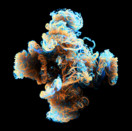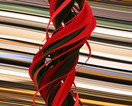Winners
The Computer Graphics Forum 2015 Cover Image has been selected by the CGF editorial board. We thanks all people who submitted this year, and hope that they will participate to the next year contest.
Winner of the Computer Graphics Forum 2015 Cover Image Contest

Jaroslav Křivánek (1), Martin Sik (1), Iliyan Georgiev (2), Toshiya Hachisuka (3), Petr Vevoda (1), Derek Nowrouzezahrai (4) and Wojciech Jarosz (5)
(1) Charles University in Prague
(2) Light Transportation, Ltd.
(3) Aarhus University
(4) Université de Montréal
(5) Disney Research Zurich
This image showcases the rendering capabilities of our unified points, beams, and paths (UPBP) algorithm. UPBP combines a number of volumetric estimators based on points and beams with Monte Carlo path sampling techniques, all of which have complementary strengths and weaknesses. It excels at rendering scenes with different kinds of media as shown in this image (from left to right: wax candle, glycerin soap bar on top of a block of a back-scattering medium, diluted wine, apple juice, and olive oil).
Second place:

Marco Ament (1), Filip Sadlo (2), Carsten Dachsbacher (1) and Daniel Weiskopf (3)
(1) Karlsruhe Institute of Technology
(2) University of Heidelberg
(3) University of Stuttgart
Vortex Cascade
This image presents a rendering of flow simulation data with our technique for low-pass filtered volumetric shadows, which was published at IEEE SciVis 2014 [1]. Our method computes soft shadows in participating media to avoid disturbing visual patterns due to hard shadows in the presence of small-scale volumetric features.
Compared to volume rendering with single scattering, our technique provides improved perception by filtering high-frequency components, which could otherwise lead to strong visual masking effects. We align a 3D summed area table with the light source for filtering, which requires no additional shadow ray marching unlike previous approaches. Our technique is also well-suited for time-dependent data, where shadow masking effects can lead to strong visual flickering. This example shows one time step of a turbulent vortex cascade, visualized with the Lambda2 vortex criterion. The large number of small tubular structures is challenging for the perception of spatial depth without advanced illumination. However, hard shadows, for example, due to single scattering, could visually interfere with the vortex features, which would be counterproductive for perception. In contrast, with our method, a user can control the softness of volumetric shadows by means of a single parameter to obtain decent visualizations.
The data set was made available by Andrea Beck from the Institute of Aero and Gas Dynamics, University of Stuttgart, Germany.
[1] M. Ament, F. Sadlo, C. Dachsbacher, and D. Weiskopf. Low-pass filtered volumetric shadows. IEEE Transactions on Visualization and Computer Graphics, 20(12): 2437-2446, 2014.
Third place(ex aequo):

Christian Schüller, Daniele Panozzo and Olga Sorkine-Hornung
ETH Zurich
This is a rendering of the pillar-forest model which was created with the help of the method proposed in "Appearance-Mimicking Surfaces" (SIGGRAPH Asia 2014). Four different 3D models are constrained to a certain depth range and split, such that they can be projected into the pillar-forest without blocking each others view spaces. Only if observed from the right viewpoint the forest will reveal its secrets!

Kaan Yucer (1), Oliver Wang (2), Alexander Sorkine-Hornung (2) and Olga Sorkine-Hornung (1)
(1) ETH Zurich
(2) Disney Research
This image is a 2D slice of a light field of a plant with red and green leaves. The light field has been captured by taking 4500 images with a camera on a boom rotating around the plant, and then slicing the resulting image stack horizontally. I.e., the image shown here essentially represents the same scanline / y-coordinate stacked from all the input views. The oscillating curves represent the foreground object, i.e., the plant, around which the camera is rotating, while the diagonal lines represent the background. In our research project we use such highly densely captured light field slices to perform accurate 3D object reconstruction in cluttered environments. For the CGF cover, one could add an example input photograph and the final reconstructed 3D model for illustration.
